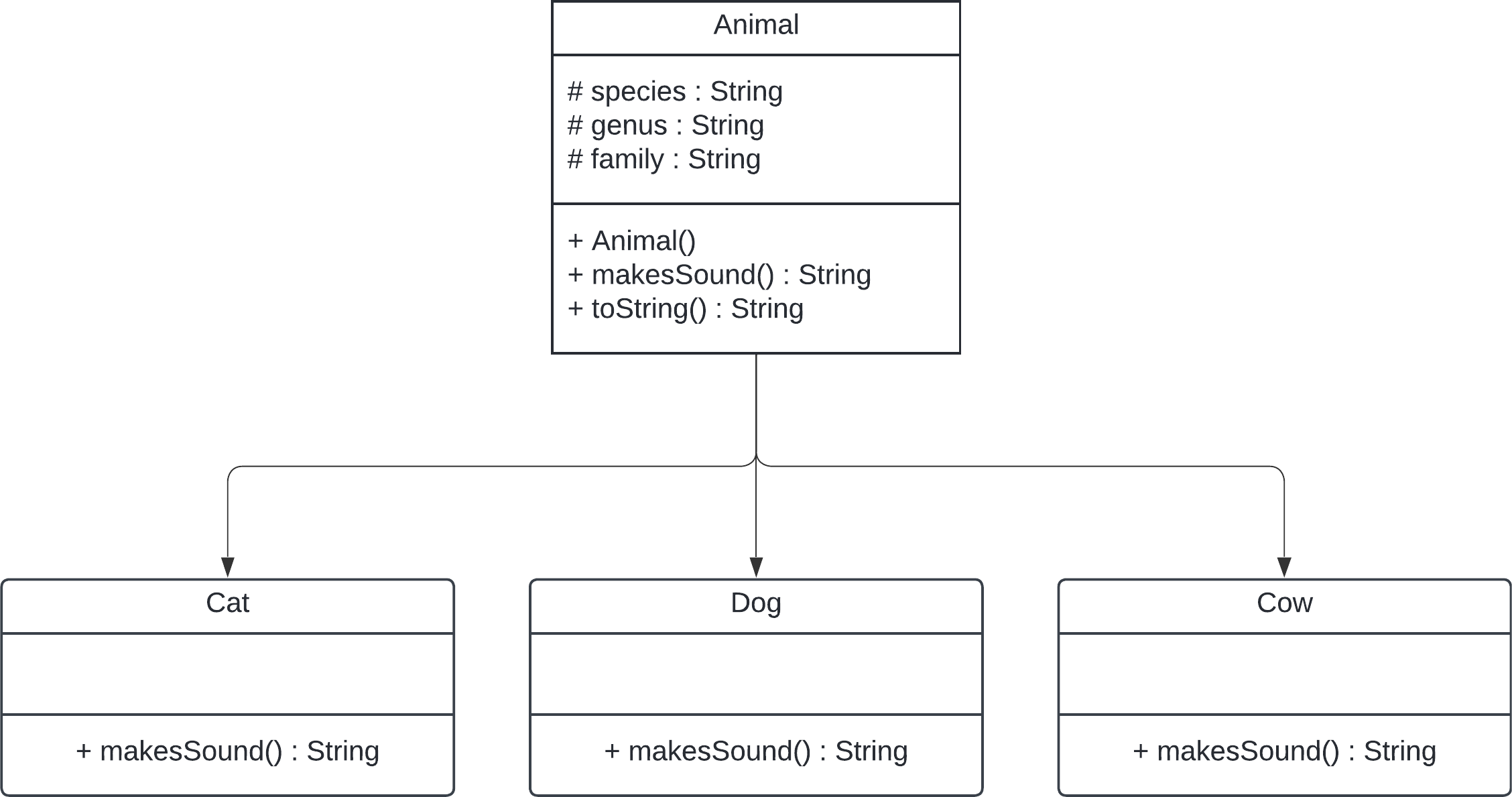Inheritance
Inheritance
Attributes and methods can be inherited from one class to another
- superclass (parent) - the class being inherited from
- subclass (child) - the class that inherits from another class
Use the extends keyword
Superclass
Create a class called Person with the following instance variables:
- First Name
- Family Name
- Birthdate
What public and private methods?
Make sure you do validation for setter methods.
Superclass – solution
import java.time.LocalDate;
public class Person {
private String firstName;
private String familyName;
private int birthYear;
private int birthMonth;
private int birthDay;
public Person(String first, String family) {
firstName = first;
familyName = family;
}
public void setBirthDate(int year, int month, int day) {
LocalDate today = LocalDate.now();
if (year > 1900 && year <= today.getYear()) birthYear = year;
if (month > 0 && month <= 12) birthMonth = month;
if (day > 0 && day <= 31) birthDay = day;
}
public String getBirthDate() {
String month;
if (birthMonth < 10) month = "0" + birthMonth;
else month = "" + birthMonth;
return birthYear + "/" + month + "/" + birthDay;
}
public String getFirstName() {
return firstName;
}
public String getFamilyName() {
return familyName;
}
public void print() {
System.out.print(firstName + " " + familyName);
System.out.println(" born on " + getBirthDate());
}
}Subclass
Create a class called Student that extends the Person class. Add the following instance variables:
- Admissions Year
- Graduation Year
- Major
- Email address (or only netID)
What public and private methods?
Write a constructor method, invoke base-class constructor using super keyword
Subclass – solution
import java.time.LocalDate;
public class Student extends Person {
private int admissionYear;
public Student(String first, String family,
int admissionYear) {
// invoke base-class constructor
super(first, family);
LocalDate today = LocalDate.now();
if (admissionYear > 1900 && admissionYear <= today.getYear())
this.admissionYear = admissionYear;
}
public int getAdmission() {
return admissionYear;
}
// override annotation
@Override public void print() {
super.print();
System.out.println("Admitted in " + admissionYear);
}
}Polymorphism
poly means many, morphs means forms
one interface with multiple implementations
Polymorphism in java:
- Compile-time Polymorphism: Method overloading
- Runtime Polymorphism: Method overriding
UML diagram
We will be using Unified Modeling Language (UML) diagrams to understand and plan classes and their inheritance.
- add name of the class at the top of each box in the diagram
- use
+/-for public/private - include instance variables, methods (including constructors) with parameters
I use the UML class template from Lucidcharts (available through google drive)
UML diagram example

Implementation example
Animal.java
public class Animal {
private String species;
private String genus;
private String family;
public Animal (String s, String g, String f) {
species = s;
genus = g;
family = f;
}
public String toString() {
String message;
message = "The " + species;
message += " of genus " + genus;
message += " and family " + family;
return message;
}
}Implementation example
Cat.java
Implementation example
Quiz 3
abstract superclass
An abstract class cannot be instantiated (an error is thrown)
An abstract class must be subclassed
Methods in an abstract class can also be abstract – similar to an interface
abstract example implementation
public abstract class Animal {
private String species;
private String genus;
private String family;
public Animal (String s, String g, String f) {
species = s;
genus = g;
family = f;
}
public abstract String makesSound();
public String toString() {
String message;
message = "The " + species;
message += " of genus " + genus;
message += " and family " + family;
message += " makes this sound: ";
message += makesSound();
return message;
}
}protected keyword
The private access modifier specifies the variable can only be accessed in its own class
The protected access modifier specifies that the variable can only be accessed by a subclass of its class
protected implementation
public abstract class Animal {
protected String species;
protected String genus;
protected String family;
public Animal () {}
public abstract String makesSound();
public String toString() {
String message;
message = "The " + species;
message += " of genus " + genus;
message += " and family " + family;
message += " makes this sound: ";
message += makesSound();
return message;
}
}protected implementation
Updated UML diagram

Update the UML diagram
The classes and inheritance relationships that we worked with so far has been simplified.
With the table mates, improve on the Animal superclass and its subclasses.
- What other instance variables should you include?
- What about methods?
You are to submit your group UML diagram to gradescope for the short assignment 6. Do not submit my UML diagram with annotations, create your own.